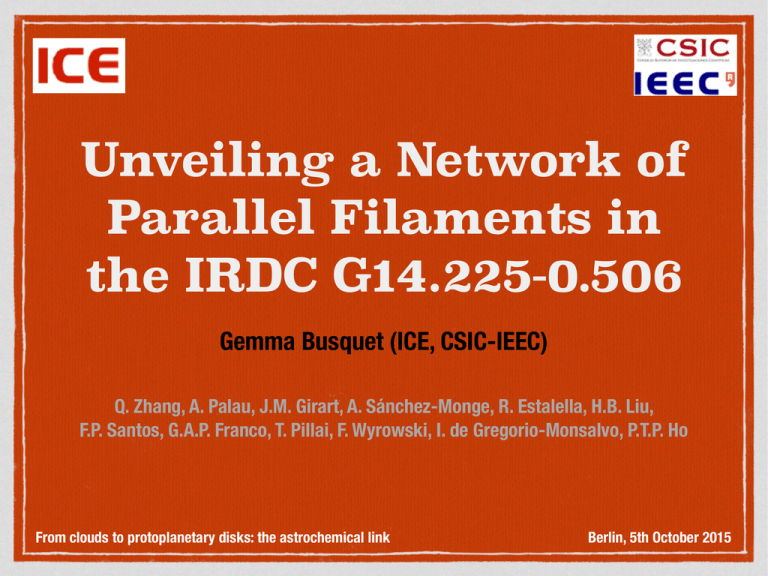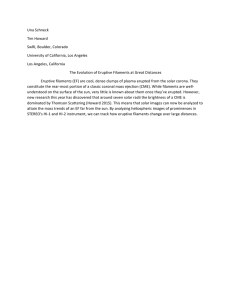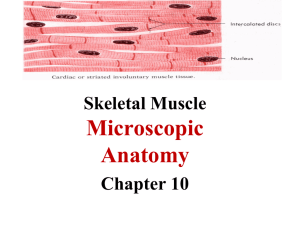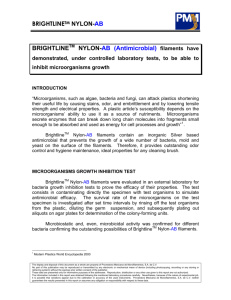Unveiling a Network of Parallel Filaments in the IRDC G14.225
advertisement

Unveiling a Network of Parallel Filaments in the IRDC G14.225-0.506 Gemma Busquet (ICE, CSIC-IEEC) Q. Zhang, A. Palau, J.M. Girart, A. Sánchez-Monge, R. Estalella, H.B. Liu, F.P. Santos, G.A.P. Franco, T. Pillai, F. Wyrowski, I. de Gregorio-Monsalvo, P.T.P. Ho From clouds to protoplanetary disks: the astrochemical link Berlin, 5th October 2015 M17 complex Discovery of an extended (77x16 pc) and massive (>105 M⦿) molecular cloud southwest of the HII region M17 (Elmegreen & Lada 1976) CO(1-0) evolution Elmegreen & Lada 1976 distance ~1,98 kpc (Xu et al. 2011) M17 complex Discovery of an extended (77x16 pc) and massive (>105 M⦿) molecular cloud southwest of the HII region M17 (Elmegreen & Lada 1976) distance ~1,98 kpc (Xu et al. 2011) Spitzer image (Povich et al. 2009, Povich & Whitney 2010) The IRDC G14.225-0.506 (M17 SWex) Povich & Whitney (2010) Several intermediate-mass YSOs identified using Spitzer data (Povich & Whitney 2010): Stage 0/I, Stage II, Stage III, ambiguous H2O maser emission (Wang et al. 2006) IRAS 18153-1651: L~1.1x104 L⦿ and IRAS 18152-1658: L~3200 L⦿ The observational project Dust continuum emission at 870 µm with APEX-LABOCA and at 350 µm with the CSOSHARC II CSO APEX Dense gas: NH3 (1,1) and (2,2) with the VLA and Effelsberg 100 m (Busquet et al. 2013) Molecular line survey at 3 mm with the IRAM 30 m telescope (Busquet et al. in prep.) Polarimetric data: optical (R-band) and NIR (H-band) using the 1.6 m telescope from the Pico Dos Dias Observatory; and 350 µm polarized emission with CSO-SHARP (Santos et al. in prep., Busquet et al. in prep.) Effelsberg VLA IRAM 30m OPD The large scale view of the cloud: NH3 Busquet et al. (2013) Extended and clumpy filamentary structure: network of 8 filaments and 2 hubs Filaments appear parallel in projection in two preferred directions at PA=10°, 60° The large scale view of the cloud: NH3 Hub-N Hub-S F10-C/W The large scale view of the cloud: NH3 Velocity dispersion locally enhanced toward hubs, while all filaments appear more quiescent Presence of two velocity components in regions where filaments intersect hubs Physical properties HUBS FILAMENTS FWHM (pc) 0.23 0.12 Aspect Ratio 5:1 15:1 Trot (K) 15 11 𝛔TOT (km/s) 1.0 0.5 Mline (M⦿ pc-1) 400 130 Hubs appear more compact, warmer, and show larger 𝛔 and larger Mline Cores within filaments have separations λobs ~0.33 pc, which is consistent with the fragmentation of an isothermal cylinder due to “sausage”-type instability λf ~0.16-0.21 pc using cs λf ~0.4-0.8 pc using 𝛔TOT The IRAM 30m survey at 3mm preliminary results The IRAM 30m survey OBSERVATIONS: OTF maps to cover the whole cloud of 9’x13’ E90 + FTS200: velocity resolution ~0.7 km/s Frequency range: 86.81 - 94.59 GHz / 102.49 - 110.27 GHz Rms ~ 40 mK 28 molecular transitions detected arising from 18 species, with Eup~4.2 - 30 K OVERVIEW: Cloud: C18O, C2H, HCN, HNC, HCO+ Dense filaments: N2H+, HC3N Shock tracers: SiO, CH3OH, CH3CN Only associated with hub-N: SO, SO2, HNCO The cloud HCO+ (1-0) HCN (1-0) optically thick and extended emission A zoo of line profiles HCO+ (1-0) wings, multiple components, self-absorption The cloud C18O (1-0) HNC (1-0) Dense filaments velocity field NH3(1,1) velocity field N2H+ (1-0) Busquet et al. (2013) Two main velocity components: vLSR~18.3-20.8 km/s and vLSR~20.8-23.2 km/s Dense filaments N2H+ (1-0) line width Line broadening usually associated with the presence of two components Dense filaments: NH- and dust N2H+ (1-0) Dense filaments: CN-molecules HC3N (10-9) HN13C (1-0) Dense filaments: CN-molecules HC3N (10-9) HN13C (1-0) CN- group of molecules brightest in filaments rather than in hubs Dense filaments: CS-molecules 13CS (2-1) H2CS (30,3-20,2) Dense filaments: CS-molecules 13CS (2-1) H2CS (30,3-20,2) CS - group of molecules brightest toward hubs Polarimetric survey Optical (R-band in red) and near-IR (H-band yellow) polarization maps Santos, Franco, Busquet et al. in preparation Polarimetric survey Optical (R-band in red) and near-IR (H-band yellow) polarization maps foreground corrected maps Santos, Franco, Busquet et al. in preparation Polarimetric survey Optical (R-band in red) and near-IR (H-band yellow) polarization maps foreground corrected maps Overall correlation between the large-scale magnetic field lines and the direction perpendicular to the cloud Santos, Franco, Busquet et al. in preparation Polarized Emission Filaments and Hubs are well orientated perpendicularly to magnetic field lines Btot ~100-500 μG Mass-to-magnetic flux ratio 0.3-2.3 MA ~0.4 - 0.8 sub-alfvénic conditions Santos, Franco, Busquet et al. in preparation Conclusions High angular resolution observations reveal a network of filaments constituting two hub-filament systems Filaments appear parallel in projection and distributed along two preferred directions at PA~10° and 60° Within each filament the velocity variations are small Network separated by two velocity components Chemical differentiation within the cloud B~100-500 μG, sub-alfvénic conditions, but does not prevent the gravitational collapse of most filaments, which in general are supercritical. THANK YOU!





